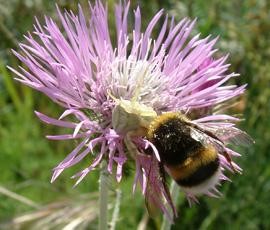
© Dr Tom Ings
Bumblebees use complex flying patterns to avoid predators according to new research from Queen Mary, University of London.
Writing in the journal Physical Review Letters, Dr Rainer Klages from Queen Mary’s School of Mathematical Sciences, Professor Lars Chittka from the School of Biological and Chemical Sciences, and their teams, describe how they carried out a statistical analysis of the velocities of foraging bumblebees. They found that bumblebees respond to the presence of predators in a much more intricate way than was previously thought.
Bumblebees visit flowers to collect nectar, often visiting multiple flowers in a single patch. There is an ongoing debate as to whether they employ an ‘optimal foraging strategy’, and what such a theory may look like.
Dr Klages explains: “In mathematical theory we treat a bumblebee as a randomly moving object hitting randomly distributed targets. However, bumblebees in the wild are under the constant risk of predators, such as spiders, so the question we wanted to answer is how such a threat might modify their foraging behaviour.”
The team used experiments that track real bumblebees visiting replenishing nectar sources under threat from artificial spiders, which can be simulated with a trapping mechanism that grabs the bumblebee for two seconds.
They found that, in the absence of the spiders, the bumblebees foraged more systematically and travelled directly from flower to flower. When predators were present, however, the bumblebees turned around more often highlighting a more careful approach to avoid the spiders.
PhD student Friedrich Lenz, who did the key analysis, explains: “We learned that the bumblebees display the same statistics of velocities irrespective of whether predators are present or not. Surprisingly, however, the way the velocities change with time during a flight is characteristically different under predation threat.”
The team’s analysis indicates that, when foraging in the wild, factors such as bumblebee sensory perception, memory, and even the individuality of different bumblebees should be taken into account in addition to the presence of predators. All of this may cause deviations from predictions of more simplistic foraging theories.
For more such insights, log into our website https://international-maths-challenge.com
Credit of the article given to Queen Mary, University of London

